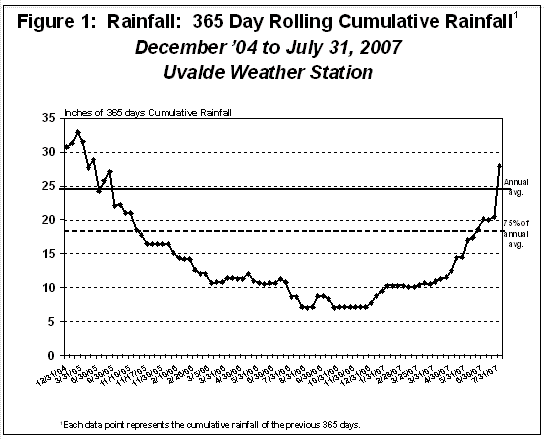AG-ECO NEWS
Vol. 23, Issue 21, August 6, 2007
Jose G. Peña
Extension Economist-Management
Drought Technically Over but It Will Take Years For Pastures and Ranges
to Recover from the Severe Drought in Southwest Texas
Rainfall in July in Southwest Texas ended at over 2.5 times the long term average for July, bringing year-to-date cumulative total rainfall to about 143 percent of the long term average. While this year’s rain, after the severe 23-month ‘05-‘06 drought, has helped green-up the region, improved forage availability and provided an excellent boost to corn, sorghum, cotton and other spring crops, the fourteen inches or more rain during May-July ‘07 was devastating to wheat, onions and to sorghum and corn harvest, which was just gaining momentum in July when concentrated rains came. The harvest resumed as open, clear, weather dried fields, but sorghum is experiencing major quality discounts and a large part of the wheat, onion and spring hay crops were lost.
Farming operations are experiencing financial losses from lost crops, but farm fields are expected to recover. And, while pastures and ranges are probably the biggest beneficiaries of the late spring rain, it will probably take years for ranges to fully recover from the severe drought, which lasted close to two years in southwest Texas, even as the drought technically ended in June. (See Figure 1). Some pastures and ranges may not recover without major improvements.
As measured in Uvalde, the southwest Texas region, entered into drought conditions (less than 75% of average annual rainfall) in mid-November 2005 and remained in severe drought conditions until mid-June ‘07. Mid-November ’05-to-mid-June ‘07, was the driest period on record. The rolling 365-day cumulative rainfall from mid-November ‘05 through mid-June ‘07, averaged 11.85 inches of rain, 51 percent below the long term annual average of about 24.34 inches. Yes, that is about 51 percent less rainfall than the average amount which has created the ecological environment, which is dependent on that rain.
Forage Availability
Forage availability is above the long term average for this time of the year, but a substantial amount of the preferred grass/forage species were lost to the drought and have been replaced with lesser quality forbs. Even with minimum livestock stocking rates, degradation of the forage production situation as a result of the extended drought will continue to have serious implication to the agricultural production situation in southwest Texas. Wildlife population densities may recover as the improved forage situation will provide better nutrition to remaining wildlife. According to some wildlife biologists, the fawn and game bird crop this spring improved after two years of decline. Wildlife resource management for profit has become the economic lifeline for many ranching operations.
Permanent Change to the Eco System?
In the final analysis, the real effect of any drought is its influence on vegetation and the vegetation’s capability to recover. The frequency of rainfall events this summer has been far beyond expectations. Whether it is enough to reestablish desirable grass species remains to be seen. In addition to continued reduced stocking rates, significantly above average rainfall will be needed for several years for favorable grass/forbs species to recover.
Without continued favorable rain conditions, the eco-system in a large portion of southwest Texas may be significantly altered and become more economically dependent on wildlife management.
Appreciation is expressed to Dr. Hagen Lippke for his contribution and review of this article.
